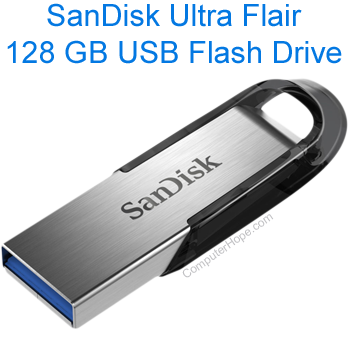How many MP3s or photos can I put on my flash drive?

The number of songs or photos that fit on a flash drive depend on several factors:
- Size of the flash drive or storage device.
- Length of the song or quality of the picture.
- Sound quality of the MP3.
Size of the flash drive
The more storage space the flash drive has, the more MP3s (audio files), photos, and videos that can be saved to the drive. For example, 5 GB capacity can hold more than 1 GB. Common flash drive sizes are 2 TB (terabyte), 1 TB, 128 GB (gigabyte), and 64 GB.
This page can also be used to determine how many pictures or MP3s can be stored on other storage devices. For example, the SD card or memory card used with your digital camera, your smartphone, or even the hard drive in your computer.
Length of the song or quality of the picture
To determine what size of flash drive to get, back up your songs or pictures and look at the size of the backup. Once you've determined the size, purchase a flash drive that meets or exceeds your requirements. See: How to determine the size of a file or folder.
General rule on file sizes
As mentioned in the MP3 files and picture (i.e., GIF and JPEG) files sections, the amount of any file varies depending on their length, quality, and overall size. The following chart provides a general idea of how many MP3 audio files can fit on a flash drive based on the average file size. For most users, they can assume their average MP3 size is 6 MB and an average photo size of 3 MB.
The numbers in the chart are based on an assumption that the operating system considers a GB to be 1,024 MB.
| Flash drive size | 8 MB MP3 | 6 MB MP3 | 3 MB Photo | 2 MB Photo | 10 MB Raw Photo |
|---|---|---|---|---|---|
| 512 MB | 64 | 85 | 170 | 256 | 51 |
| 1 GB | 128 | 170 | 340 | 512 | 102 |
| 2 GB | 256 | 341 | 682 | 1,024 | 204 |
| 3 GB | 384 | 512 | 1,024 | 1,536 | 307 |
| 4 GB | 512 | 682 | 1,364 | 2,048 | 409 |
| 5 GB | 640 | 853 | 1,706 | 2,560 | 512 |
| 6 GB | 768 | 1,024 | 2,048 | 3,072 | 614 |
| 8 GB | 1,024 | 1,365 | 2,730 | 4,096 | 819 |
| 16 GB | 2,048 | 2,730 | 5,460 | 8,192 | 1,638 |
| 32 GB | 4,096 | 5,461 | 10,922 | 16,384 | 3,276 |
| 64 GB | 8,192 | 10,922 | 21,844 | 32,768 | 6,553 |
| 128 GB | 16,384 | 21,845 | 43,690 | 65,536 | 13,107 |
| 256 GB | 32,768 | 43,690 | 87,380 | 131,072 | 26,214 |
MP3 file sizes
Flash drive is often interchanged with USB flash drive, data stick, pen drive, memory unit, keychain drive, and jump drive.
The term memory stick is often improperly used when referring to a flash drive.
If the MP3 file is created at 128 kbit/s quality (the bitrate), the file size will be about 1/11th the original music CD file size. However, the original size is not always known.
A fairly common MP3 quality is 256 kbit/s. Downloading MP3 songs from Amazon.com or iTunes gets you this quality of MP3 file. There are other sources for MP3 files on the Internet, ranging from 128 kbit/s to 320 kbit/s.
On average, let's say a song is 3 1/2 minutes long. At this length and 256 kbit/s quality, the MP3 file size would be 6.56 MB. At three minutes, the file would be 5.62 MB and four minutes would be 7.5 MB.
If the MP3 songs are higher quality (320 kbit/s), you won't be able to fit quite as many on the flash drive since the file sizes would be larger. If the quality was lower (192 kbit/s or 128 kbit/s), you could fit more MP3s on the flash drive.
Ultimately, how many songs fit depends on your preference of MP3 sound quality. Lower bit rate results in lower sound quality, but more songs on the flash drive. A higher bit rate results in higher sound quality, but fewer songs on the flash drive.
Picture (e.g., JPEG and GIF) sizes
A camera can take a picture in many different file sizes, depending on the quality of the picture and the type of camera used. Therefore, the quantity of pictures a flash drive can store can vary depending on the size of each picture.
Generally, most cameras take pictures that are around 3 MB in size. A cell phone camera usually takes a 2-3 MB picture at its highest setting, and an SLR camera taking photos in the RAW format can be as large as 10 MB.
